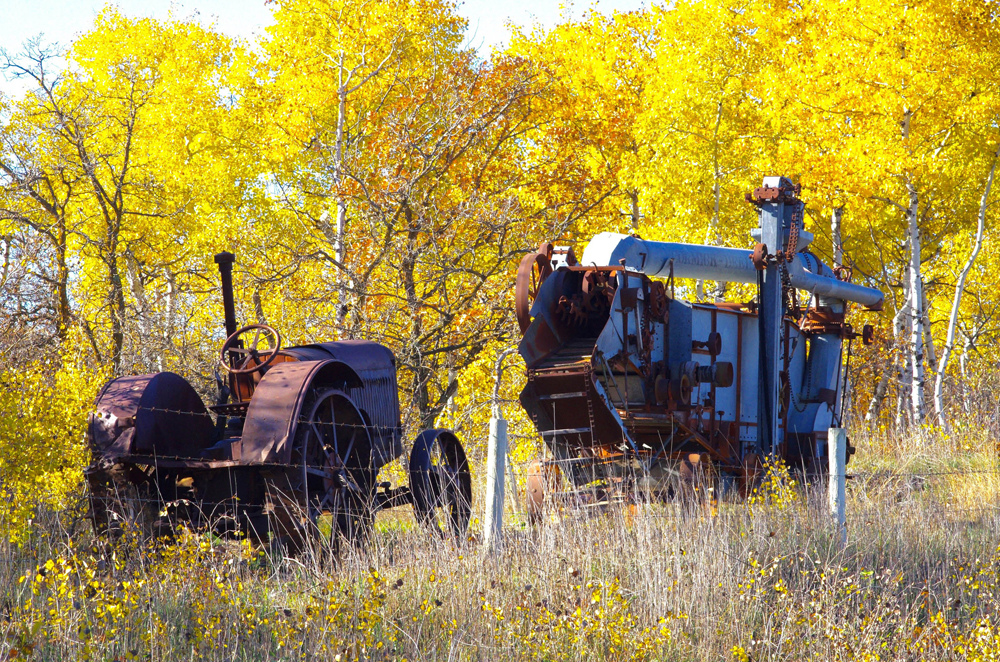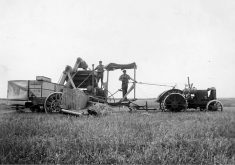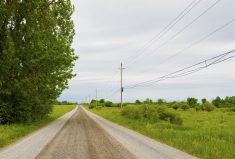Editor’s note: The final story in our series exploring the complex factors behind rural depopulation in Manitoba, why it matters, the solutions that have been tried and what keeps young people in small communities. Read parts one, two, three and four here.
It’s a snowy day in rural Japan. Inside the classroom, many kids are still wearing their coats and hats against the chill. They sit with rapt attention, gazing forward with books open before them.
Not one twitches. There are no wiggles or coughs. No one turns a page. The only moving person is a retirement-aged woman sitting in the centre of the room.
Read Also

Manitoba to boost rural medical responders
Manitoba bursary aims for more accessible emergency medical responder training, better rural emergency health care.
That’s because, except for Tsukimi Ayano, everyone there is a doll-like scarecrow.
“In this classroom, I recreated a parent visiting day, like how it used to be when there were people and action.” Tsukimi says to the camera.
Her words are translated into English at the bottom of the video, later published by the South China Morning Post in 2019. The school closed in 2012, the video says.
At the time of filming, there were more scarecrows than people in the mountain village. The youngest of the 27 remaining residents was 55 years old. There were 270 scarecrows. Tsukimi made the figures to repopulate the town and to draw tourists to the area.
Japan’s population is shrinking. Immigration is minimal and the birth rate is catastrophically low — so low that some worry the number of women of child-bearing age will dip to the point that the decline will be irreversible, CNN said in a March 2023 article. But it’s the rural areas bearing the brunt as young people leave for education or work, the Economist wrote in 2019. At the time, half of the country’s municipalities were projected to disappear by 2040.
While there are fewer local scarecrows, a drive down the rural roads of Manitoba will unearth plenty of lonely signs and cairns where communities once stood, complete with stores and schools. Today, a gathering of houses might be all that is left.

Why it matters: The past four articles in this series (find links at top) have explored the how and why of depopulation in rural Manitoba. But rural decline is a reality in much of the world. Can it really be rolled back?
Manitoba’s concern with the drain of rural young people towards cities stretches back for decades, beginning in earnest after the Second World War, with accelerated farm mechanization, changing agriculture needs and changing lifestyles of residents. Farms rapidly evolved from small family operations to highly mechanized, sophisticated, export-oriented businesses. Those who didn’t get big, got out. Improvements to rural infrastructure, which expanded road systems and strung electrical and telephone lines into far-flung farming communities, made rural life easier and more convenient, but it also made it easier to move away.
By the late ’60s, the provincial government had noted the rural exodus, and became concerned about its economic impacts. The Scheyer government introduced the Stay Option policy, which pumped investment into agriculture and rural communities, in an effort to entice youth to stay.
A quick look at census data reveals little measurable benefit from the policy, which was quickly followed by the drought and economic crisis of the 1980s. The financial realities made farming a hard sell for kids coming out of high school.
In the modern day, despite programs trying to stem the tide, census data show that Manitoba had less than half the farms in 2021 as it did in 1976. Rural population between 2016 and 2021 shrunk by 1.7 per cent, although the drain of young people between the ages of 20-24 to cities has slowed in recent decades. Including a drop during the pandemic, the rate of people 25-29 moving the other way from the city to the countryside, has actually been on the rise since 2011.

Rural decline: a policy choice?
A 2019 paper in the Journal of Rural Studies opens with the line: “Rural decline is an inevitable process as human society transforms from the agrarian to the urban-industrial economy, and further on to the knowledge economy.”
That seems to match with the many sea changes, and their impacts, noted in Manitoba’s agricultural sector in the years following World War Two.

However, researcher Sean Markey suggests that policy choice, or lack thereof, can also be blamed for rural depopulation. Governments didn’t have to adopt a shrug-off attitude of “mechanization, oh well … that’s the way of the future,” he said.
Markey, a professor with the School of Resource and Environmental Management at Simon Fraser University, argued that governments could have supported small farmers and diversified rural economies through things like investment in value-added production. They also could also have done more in terms of coherent rural development policy and infrastructure investment.
In the post-war period, governments were “very interventionist” in supporting rural growth, Markey said. This included the previously mentioned road and hydro improvements, along with community-building work.
“From a rural industrial perspective … they wanted stable communities that would then support a stable industrial workforce in these rural regions,” Markey said, adding that this trend began to reverse in the ‘70s and ‘80s.
Austerity and the end of the Stay Option
Succeeding Schreyer and his Stay Option’ policy, Sterling Lyon was elected Manitoba’s premier in 1977. He roundly criticized the former government’s spending habits and, in the face of a struggling economy, went on a run of austerity measures. A May 1978 article in the Winnipeg Tribune described the administration as “in the running for toughest government in Canada.”
Social perspectives were also changing. Neoliberalism, defined by the Encyclopaedia Britannica as an “ideology and policy model that emphasizes the value of free market competition … often characterized in terms of its belief in sustained economic growth,” was on the rise, spurred by perceived failures of the more interventionist approaches popular in the post-war period. On the global stage, national leaders like Margaret Thatcher and Ronald Reagan were coming into power.
As this became the prevailing mindset, investment in — among other things — rural development and infrastructure waned, Markey said. Communities were increasingly left to do their own development.
“For the past 30 years, rural places have … struggled with the outcomes of those decisions,” he said.

Crumbling infrastructure
Around 2016, Canada’s federal government began to increase investment in infrastructure, which included things like broadband internet service, Markey said.
Kerry Black, Canada research chair for integrated knowledge, engineering and sustainable communities at the University of Calgary, puts that turnaround at approximately 2010. In a March 2023 article from the Conversation, Black said that year marks the point where federal investment in infrastructure began to rise from 1.5 per cent of GDP. Public investment had declined from around three per cent of GDP in the 1950s to 1.5 per cent in the late 2000s.
In early 2023, Canada’s infrastructure deficit totaled around $150 billion, Black wrote. Infrastructure spending increased out of necessity.
“Infrastructure was basically crumbling around rural communities, and there was a recognition that the market wasn’t going to solve all of our problems,” Markey said.
Crumbling infrastructure had led to a decline in productivity, the Canadian Chamber of Commerce wrote in a 2013 report. For instance, the nation’s manufacturing output lagged the U.S., where infrastructure spending was much higher.
The report further argued that deteriorating roads and ports were a danger to Canada’s import and export capacity, adding that a poor transportation network hurts both businesses and quality of life.
Though federal spending may have increased, Manitoba municipalities say they’ve struggled to maintain the bulk of infrastructure. In 2021, the Association of Manitoba Municipalities said one-third of core municipal infrastructure was in fair, poor or very poor condition. “Which is concerning, given that municipalities manage 60 per cent of Manitoba’s infrastructure despite collecting less than 10 cents of every tax dollar,” AMM said in a 2021 position paper.
Provincial funding to municipalities was also frozen from 2016 to 2022.
Investment is a good start, but more than money is needed, Markey said. The investment is “not particularly coherent or well-co-ordinated,” he said. “For instance, there is no vision for rural Canada at a federal level … we tend to sort of still react and not put together a comprehensive plan for what we see as the future of rural Canada.”
A 2022 overview of Canadian rural development policy, which Markey co-authored, found that targeted approaches for rural development are rare. Most development programs and strategies target overarching provincial and regional needs and are specific to a single sector, such as agriculture.
Does it matter?
Markey refuses to take a doom-and-gloom outlook on rural communities. He pointed to one Globe and Mail opinion piece, which predicted Canada would become a collection of cities with empty land in between.
“Such a ridiculous comment,” he said. “Rural Canada is growing. It’s just growing less quickly than urban places.”
While census data show a decrease in rural populations, Statistics Canada’s annual demographic estimates bear out Markey’s argument. From 2020 to 2022, the estimates suggest that rural Manitoba’s population grew from 388,578 to 393,892, an addition of 5,314 people. In the same window though, the province’s urban centres added 24,021 people.
Communities that maintain an investment mentality, understand they can support their businesses and industry and offer high quality of life will likely be successful, Markey said.
“People love living there, right?” he said. “They want to live there.”
Indigenous communities, many of which are growing, are also predominantly rural.
“There’s tremendous amounts of economic opportunity,” Markey said. “Rural communities play incredibly important roles in our resource economy.”
He further argued that the province needs a shift back to that investment mentality, as well as a better understanding of how much potential rural places have, “not just viewing them as sort of resource hinterlands that are inevitably in a state of decline.”
















